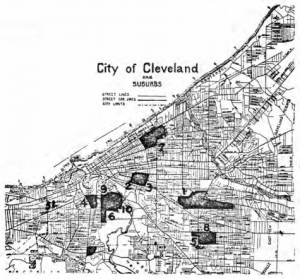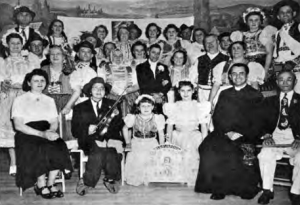Part IV: The Slovak Community of Cleveland
Slovak Neighborhoods
When one traces the lives of a sample of Slovaks at any Cleveland parish before 1940, one discovers that they clustered around their churches. A sample of 100 families at St. Wendelin’s parish in 1924 showed, for instance, that 84 of them lived in a small triangle between Columbus Road, Willey Avenue and West 17th Street. All one hundred were within ten blocks of the church. Similar results were obtained in a study of St. Ladislas, SS. Cyril and Methodius and Nativity parishes. Indeed, Cleveland area Slovaks clustered in eight distinct neighborhoods of residence, each having at least one Roman Catholic and perhaps also a Lutheran, Greek Catholic, or Calvinist church, as outlined earlier.
Neighborhood Solidarity
Many of the Slovaks saved their money and invested it in housing. Furthermore, they encouraged older children to live with the family for a few years after marriage in order to increase the total family income, which could also be used to buy more property. By investing in property and trying to keep the entire family nearby, American Slovaks became very attached to their neighborhoods and resisted moving about. As a result, when Blacks and Appalachians began to move into Slovak neighborhoods in the 1950’s and 1960’s, they encountered resistance. Later the Slovaks resettled largely in Parma, Bedford, and Garfield Heights.
East and West Clash
The loss of their neighborhoods was only one of a series of crises that American Slovaks experienced. They initially had to contend with a strange Catholic Church that was more Irish than Roman. We have already seen that soon after arriving in Cleveland, Catholic Slovaks established their own parishes. They did so not only because they wished to worship in their own language, but because the typical American parish in the 1880’s was Irish and featured the lifeless “Low Mass,” a relic of English persecution of the Irish in the Old World. Slovaks, as other Eastern Europeans, preferred the exuberant “High Mass” with its singing and ritual.

| 1. St. Ladislas’ Church | 6. St. John’s Church |
| 2. Holy Trinity Church | 7. St. Andrew’s Church |
| 3. St. Martin’s Church | 8. St. Joseph – Greek Catholic Church |
| 4. St. Wendelin’s Church | 9. Martin Luther Church |
| 5a. Nativity Church | 10. First Baptist Slovak Church |
| 5b. St. Cyril & Methodius was also built in 1903 in Lakewood |
Neighborhood Segregation
Oftentimes, the arriving Slovaks had to withstand hostility from native Americans and even sometimes from the Irish, who earlier had experienced some of the same treatment that was now being accorded the Eastern Europeans. Both groups refused to live beside Eastern Europeans, preferring to move to “better” neighborhoods. Thus between 1880 and 1914, Cleveland’s near West Side, formerly almost totally Irish and German, became increasingly Eastern European. The pattern of segregation of American cities began, when native whites refused to live with “inferiors.”
Old World Village Cohesion
A closer look at the records of four Cleveland Slovak parishes reveals that in each case a significant core of the worshippers hailed from the same area in the Old World. Marriage records of St. Ladislas parish for the years 1889-1892 reveal a distinct concentration of people from the upper Torysa River Valley in the district of Sabinov, county Šariš. At St. Wendelin’s, the people who married between 1903 and 1908 came largely from a small triangle of villages bounded by the towns of Kežmarok, Poprad and Spišská Nová Ves in county Spiš. Judging from the earliest records of Holy Trinity parish, people who joined this congregation between 1892 and 1898 came largely from southern Šariš in the district of Drienov. Finally, members of the Slovak Calvin Presbyterian parish of Lakewood originated almost exclusively in the western tip of Užhorod county. The records thus reveal a clear pattern of chain migration (one immigrant following another from the same village to the same city in America) from Eastern Slovakia and they also show that individual parishes arose on the basis of these chains.
Endogamy Prevails
Furthermore, the marriage records of Slovak parishes illustrated a continuing pattern of village endogamy. Records of ten Slovak villages that sent large numbers of immigrants to America reveal that they had a 62 percent rate of village endogamy (people taking partners from the same or neighboring village) in the years 1853-1888. The four Cleveland Slovak parishes mentioned directly above had partners from the same or neighboring villages in 50 percent of all marriages. Thus, although the rate of village endogamy did drop slightly, it still encompassed half of all first generation Slovak marriages in Cleveland.

